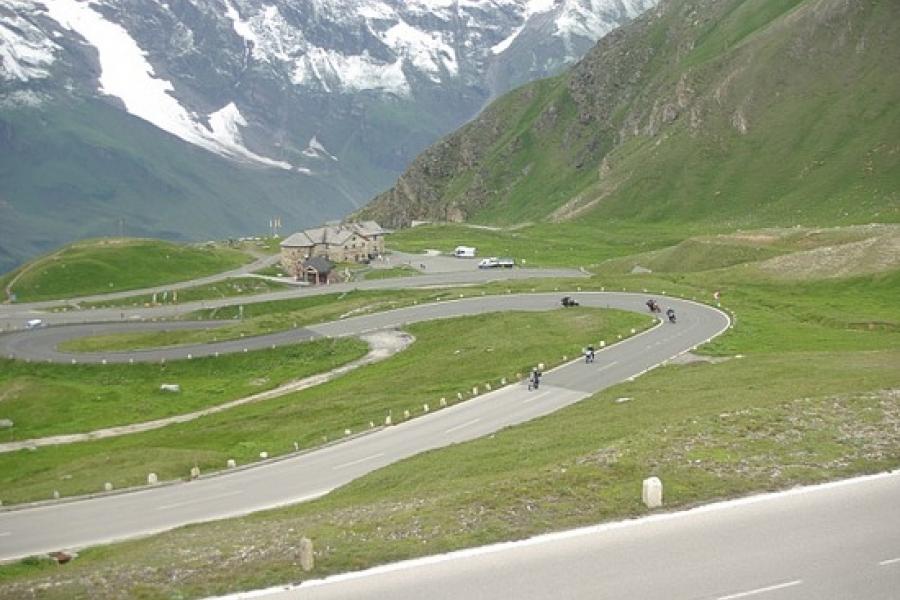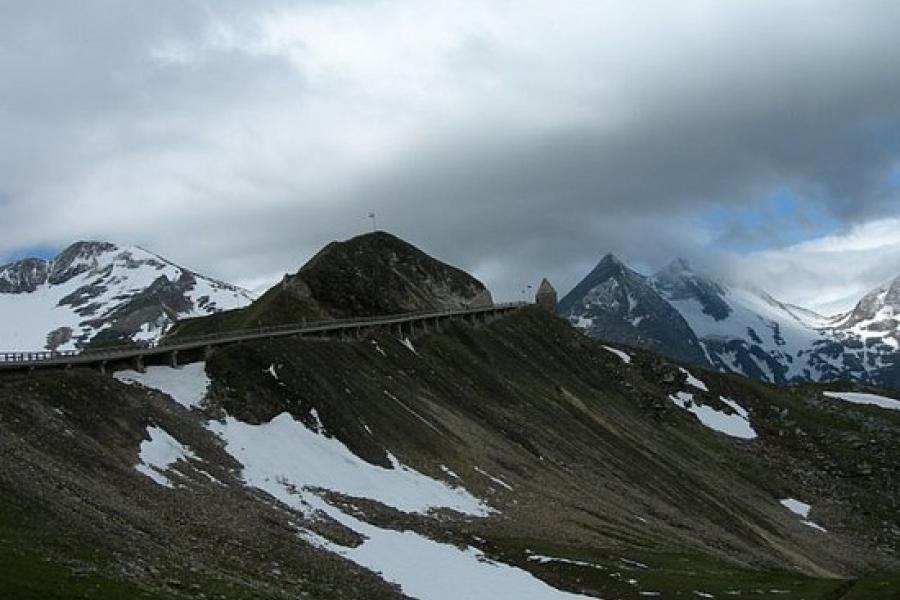A Pass on the Mountain (This blog was originally posted on 11 July 2011 on the Travelpod site)
Country
Having found the cabin, we were full of good will towards the world and rode south again towards the Grossglockner Hochalpenstrasse, Grossglockner for short. This famous alpine road is 48 km long with 36 bends and an altitude ascent of 2 504 metres. Just outside the town of Zell um See the drizzle which had plagued us all day disappeared and was replaced with some genuine heavy rain. We rode under the cover of an awning at a car dealership to rig for wet running. Two Italian bikers had the same idea and pulled in beside us. We had a quick chat while we pulled on our rubber suits. They had just come back from the Grossglockner and it was closed because of snow. They would have to go further west to a lower pass to find their way back home.
Disappointed, we settled on a gasthaus in Zell am See for the night and planned an alternate route. The next morning we looked out on one of those cool crystal blue days that are the best of the summer in these parts. We had a quick Austrian breakfast of dark bread, cold meat, cheese and coffee and wasted no time getting on the road. Our plan was to try the Grossglockner and, if it remained closed, head further west to a lesser pass. By the time we reached the sign which confirmed that the pass was open and started to climb out of the last high village, it was warm and clear, the road was dry and fast, and Just Sue was flying along.
The Grossglockner road is privately run and costs 19 Euro one way for a bike. This, and the steepness and difficulty of the road, meant that heavy vehicles, caravans and most of the motor-homes took a lower pass further west. What remained to pay the toll were bikes (lots of them) and a few tourists. For our 19 Euro we got a brochure, a sticker and the right to ride back and forth between the gates as many times as we liked. Keen riders did just that, turning around before they went through the gate at each end and returning over the mountain. This might seem a little extreme, but no one gets the most out of the first ride over. The mountains are so stunning that everyone made many stops to take photos, wave to other riders and generally enjoy the whole carnival of the thing.
This was not Team Elephant's first high mountain pass, nor was it the most challenging we had done. That award goes to Dades Gorge in Morocco which clambered up through endless hairpins, treacherous with ice and bitterly cold. In comparison, the Grossglockner was just great fun. The corners (I don't recall any straight bits) varied between wide sweepers and dead-slow switch-backs, the road surface was good and the other users sensible and considerate. We had a great hoot of a day and, although we only crossed once and stopped many times, we thought the toll was well spent.
Off the Grossglockner, we kept going south across the Italian frontier into the Dolomites and across three more high passes before the day was done. We stopped at the small town of Arabba which was positioned in the centre of this mountainous region and from which the determined could ride 17 passes in a single bum-numbing day. Leaving Arabba the next morning the Passo Pordoi started at the end of town. I remember thinking, hell, I'm not ready for this yet as the first corner loomed up. I hauled Just Sue through the switchback exiting a little early and wide, then settled to the task and reeled off a further 33 switchbacks on the way to the top of the pass. By the time we had a quick photo stop to look back on a now distant village I had decided that this was going to be a very good day at the office.
Over the next two days we criss-crossed this fascinating place until our highlighted route on the map looked like the scrawl of a child and we had “bagged” more than a dozen passes. We stayed in B&Bs in tiny out of the way bolt-holes where there are no signs because... well, because everyone knows where everything is, and enjoyed the whole circus of the mountain roads and those who come to experience them. Apart from bikers, the other group who are keen on bagging the passes are the bicyclists. There are hundreds on the mountain roads and some care is needed from drivers to ensure their safety. They cover the full range of ages and fitness from the very casual, winding away slowly in a very low gear and barely making walking pace, to the fit young guns on team bikes flogging along.
The long grind to the top of a 2,500 metre pass is one part of the adventure. Flying back down the hill is quite a different experience. On several occasions, we sat back from riders flying through the corners at 60 km/h. For those who are not cyclists, this is scary fast. At the top of the passes, the souvenir stalls have riding tops and nics with the name of the pass. A few were quite stylish but since I haven't peddled up one of these passes (yet), I resisted the temptation to add one to my cycling wardrobe.
Just for the record keeping, by the time we headed west towards the Stelvio pass and the roads into Switzerland,we had bagged the following passes:
- Grossglockner Hoc Tor
- Grossglockner Fuscher Tor
- Bernina Pass
- Julier Pass
- Passo di Sella
- Passo Pordoi
- Passo di Giau
- Passo di Valparola
- Grimsel Pass
- Passo di Gardena
- Passo di Falzarego
- Passo di San Pellegrino
- Iselsberg
It seemed like a good list already and we still had some of the great passes in front of us including the Stelvio and the Oberlap which are considered to be the best motorcycle roads in the world..











































